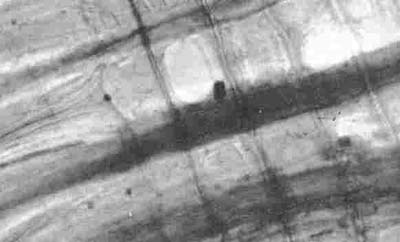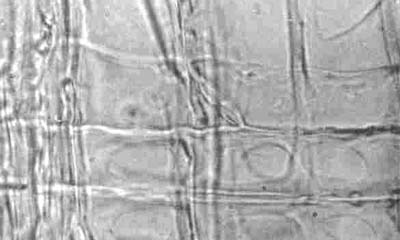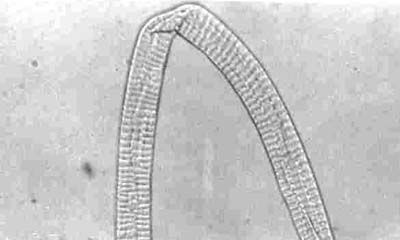
Bulletin 2 (I:2), December 1963
Home
Français
Introduction
History
Annual Index
Author &
Subject
Credits
Contact




From the Laboratory of the National
Gallery
by Nathan Stolow,
Chief Conservation and Scientific Research
Division
Pages
1 | 2
| 3 | 4
| 5
Other Investigations
Scientific investigations may be carried out in the context of
conservation treatment, as in the cases of The Toilet of Venus, and
Le Pont de Narni, as described earlier, or they may be
motivated by deterioration problems of another kind. On the other
hand, analyses may be required in questions of authenticity.
In conclusion a few examples reflecting the application of
laboratory investigation in these fields are given:
Investigation of Mould:
A number of paintings when returned to Canada from Sao Paulo
Biennale of 1960 were found to be encrusted on the surface with
mould. Laboratory investigation confirmed the existence of fungus
which was disfiguring the paint surface (see Fig. 19).
"The material removed from the paintings is the mycelium and
fruiting bodies of a fungus. The coenocytic hyphae of the mycelium,
black spores, and spherical sporangium terminal on the long
sporangiophore, suggest Rhizopus nigricans or Mucor
mucedo. A few of the hyphae are septate - this may indicate a
mixed culture, the septate mycelium probably belonging to Aspergillus
niger." (25)
The optimum growing conditions for such fungi are 15 to 30 degrees
centigrade with the relative humidity in the range of 95 to 100%.
Growth can occur, however, in an environment with relative humidity
as low as 70% . In general it is possible to remove the mould growth
from the surface of a painting by mechanical means, usually combined
with fungicidal washes. The efficiency of removal would depend on a
number of factors such as the topography of the paint film, the
chemical nature of the paint film and its continuity, the remanent
action of the fungicide, and the chemical reactivity of the residual fungicide with the paint film itself. (26)
It is now standard practice in the National Gallery to apply
fungicide to backs of paintings prior to shipment to countries where
conditions conducive to fungus growth might exist. At the same time
the entire packing case is disinfected using the same fungicide as
has been used on the painting. Further precautions are taken by
installing humidity and temperature buffers within the packing case
to minimize tendencies for humidities to build up. (27)
Identification of Wood in "Viking" Sculpture:
In the latter part of 1960 there was the occasion to examine a sculptured head in wood which was dredged out of the Gaspé area (Percé), and thought by some to be of Viking origin. (28) The head, 10 1/4 inches high, and polychromed, is shown in Fig. 20. Examination of the wood by a standard method of thin sectioning and staining, followed by microscopic observation showed that it was Pinus Strobus L. or Eastern Canadian White Pine, rather than a wood of Scandinavian origin. Examination of moss-like residues on the base of the sculpture were identified as fresh water micro-organisms, and confirmed that the sculptured head came from a fresh water environment. There was no evidence to show that it had been immersed for hundreds of years in sea water. (29) The cross-sections of wood are illustrated in Fig. 21, and the fresh water algae in Fig. 22. It can now be assumed that the sculptured head is probably no more than 150 years old, and is of eastern Canadian origin.
Solvent Action Studies:
Previous fundamental studies on the action of solvents on aged
linseed oil films have been continued. (30, 31) The information
gained from such research is of value in understanding more
completely the mechanism of action of solvent on varnish and on
paint during the cleaning of pictures. By attempting to identify the
nature of the leached materials from paint films it is possible to
determine more precisely the reactivity of linseed oil films to
solvents. The methods of micro-chemistry, infra-red spectroscopy,
and gas chromatography are proving most useful in this regard.
Essentially interest is being focused on the fatty acids, esters,
and breakdown products which are extractable from aged paint, and
which lend themselves to positive identification.
Next Page | Notes
1 | 2 | 3
| 4 | 5
Annual Index | Author & Subject | Credits | Contact
This digital collection
was produced under contract to Canada's Digital Collections program,
Industry Canada.
"Digital
Collections Program, Copyright
© National Gallery of
Canada 2001"